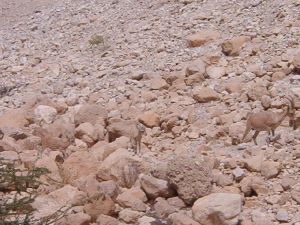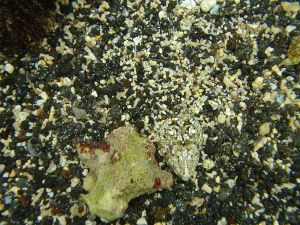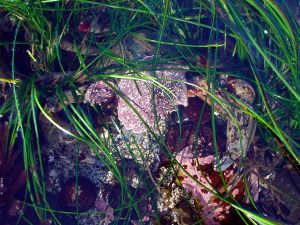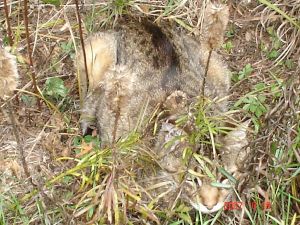Camouflage
Camouflage is any natural or artificial means by which an organism is disguised such as to remain difficult to detect in the surrounding environment. Examples include a tiger’s stripes and the battledress of a modern soldier. A cuttlefish can not only rapidly change its colors, color patterns, and color intensity to blend with its background, but this cephalopod can even change skin texture to match its habitat, better concealing itself as its moves among the various sandy areas, corals, and rocks of its marine environment.
Cryptic coloration is a type of camouflage whereby organisms in nature are difficult to spot visually against its surrounding background due to particular hues, lightness, and/or color patterns blending with the environment. Examples of such protective coloration include a brown praying mantid looking like a twig on a plant or the countershading of a fish, whereby the darker shades on the dorsal surface make the fish more difficult to detect from above and the lighter ventral shades make it more difficult to spot from below.
Natural camouflage
In nature, there is a very common tendency for animals to blend into their environment or conceal their shape. This assists prey animals to avoid predators and for predators to be able to sneak up on prey.
Some cryptic animals also simulate natural movement, such as that of a leaf moving in the wind. This is called procryptic behavior or habit. Other animals attach or attract natural materials to their body for concealment.
A few animals have chromatic response, changing color in changing environments, either seasonally (ermine, snowshoe hare) or far more rapidly with chromatophores in their integument (chameleon, the cephalopod family). With the exception of nautilus, cephalopods have special skin cells called chromatophores that very rapidly change color and are used for camouflage (and communication). Chromatophores contain yellow, orange, red, brown, or black pigments; most species have three of these colors, while some have two or four. Other color-changing cells are reflective iridophores, and leucophores (white) (Meyers 2006). Cuttlefish are known as "chameleons of the sea" for their ability to change skin color and patterns, although the cuttlefish color changes are actually much faster and more intricate than that of the chameleon, changing as they swim over different surfaces.
Octopuses and cuttlefish are also noted for the ability to change the texture of their skin to match their environment, such as having bumpy projections when over a coral reef or smooth skin when over sand. The mantle of the mimic octopus (Thaumoctopus mimicus) can take on the spiky appearance of seaweed, or the scraggly, bumpy texture of a rock, among other disguises.
Some animals, notably in aquatic environments, also take steps to camouflage the odors they create that may attract predators. The large cloud of thick blackish ink ejected by an octopus when a predator attacks not only hides the animal, but also helps dull the smell.
Some herd animals adopt a similar pattern to make it difficult to distinguish a single animal. Examples include stripes on zebras and the reflective scales on fish. The stripes of a zebra are felt to accomplish camouflage in several ways (HSW 2007). First, the vertical striping helps the zebra hide in grass. While seeming absurd at first glance considering that grass is neither white nor black, it is supposed to be effective against the zebra's main predator, the lion, which is colorblind. Theoretically, a zebra standing still in tall grass may not be noticed at all by a lion. Additionally, since zebras are herd animals, the stripes may help to confuse predators—a number of zebras standing or moving close blend together, making it more difficult for the lion to pick out any single zebra to attack (HSW 2007). A herd of zebras scattering to avoid a predator may also represent to that predator a confused mass of vertical stripes traveling in multiple directions making it difficult for the predator to track an individual visually as it separates from its herdmates.
Countershading (or obliterative camouflage) is the use of different colors on the upper and lower surfaces, graduating from a light belly to a darker back. It is common in aquatic and terrestrial environments. This commonality is sometimes called Thayer's law, after Abbott H. Thayer who published a paper on the form in 1896.
Camouflage is a type of crypsis, which is the ability of an organism to avoid observation in general, and includes not only camouflage, but also nocturnality, subterranean lifestyle, and transparency (Zuanon and Sazima 2006). The word crypsis also is used in the context of eggs (Nguyen et al. 2007), and pheromone production (Raffa et al. 2007). Cryptic animals include the tawny frogmouth (feather patterning resembles bark), the tuatara (hides in burrows all day; nocturnal), some jellyfish (transparent), and the flounder (covers itself in sediment).
Cryptic coloration
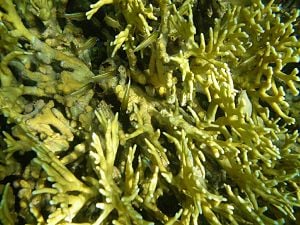
Cryptic coloration is a type of camouflage that makes creatures difficult to spot visually against their background due to use of particular colors or color patterns. This is the most common form of camouflage, found to some extent in the majority of species. (Exceptions include large herbivores without natural enemies; brilliantly-colored birds, which rely on flight to escape predators; and venomous or poisonous animals, which advertise with bright colors.)
The simplest way is for an animal to be of a color similar to its surroundings. Examples include the "earth tones" of deer, squirrels, or moles (to match trees or dirt), or the combination of blue skin and white underbelly of sharks via countershading (which makes them difficult to detect from both above and below). More complex patterns can be seen in animals such as flounder, moths, and frogs, among many others. Some forms of camouflage use contrasting shades to break up the visual outline, as on a gull or zebra.
The type of camouflage a species will develop depends on several factors:
- The environment in which it lives. This is usually the most important factor.
- The physiology and behavior of an animal. Animals with fur need different camouflage than those with feathers or scales. Likewise, animals that live in groups use different camouflage techniques than those that are solitary.
- If the animal is preyed upon, then the behavior or characteristics of its predator may correlate with the type of camouflage. For example, if the major predators have achromatic vision, then matching the color of the surroundings is not essential to the organism. .
Animals produce colors in two ways:
- Biochromes are natural microscopic pigments that absorb certain wavelengths of light and reflect others, creating a visible color that is targeted towards its primary predator.
- Microscopic physical structures may act like prisms to reflect and scatter light to produce a color that is different from the skin, such as the translucent fur of the polar bear, which actually has black skin.
In some species, the camouflage coloration can change over time. This can be in response to the changing of the seasons, or it can be in response to more rapid environmental changes. For example, the arctic fox has a white coat in winter and a brown coat in summer. Mammals and birds require a new fur coat and new set of feathers respectively. Cuttlefish have deeper-level pigment cells, called chromatophores, that they can control and change almost instantaneously as they swim over different marine backgrounds. Some animals, such as certain fish species or the nudibranch, can actually change their skin coloration by changing their diet. The most well-known terrestrial creature that changes color is the chameleon; however, it usually does not do so for camouflage purposes, but instead as a product o its mood.
Beyond colors, skin patterns are often helpful in camouflage as well. This can be seen in common domestic pets such as tabby cats, but striping overall in other animals such as tigers and zebras help them blend into their environment, the jungle and the grasslands respectively. The latter two provide an interesting example, as one's initial impression might be that their coloration does not match their surroundings at all, but tigers' prey are usually color blind to a certain extent such that they cannot tell the difference between orange and green, and zebras' main predators, lions, are color blind. In the case of zebras, the stripes also blend together so that a herd of zebras looks like one large mass, making it difficult for a lion to pick out any individual zebra. This same concept is used by many striped fish species as well. Among birds, the white "chinstraps" of Canada geese make a flock in tall grass appear more like sticks and less like birds' heads.
Mimicry
Mimicry describes a situation where one organism, the mimic, has evolved to share common outward characteristics with another organism, the model, through the selective action of a signal-receiver. The model is usually another species, or less commonly, the mimic's own species, including automimicry, where one part of the body bears superficial similarity to another. The signal-receiver is typically another intermediate organism, e.g the common predator of two species, but may actually be the model itself. As an interaction, mimicry is always advantageous to the mimic and harmful to the receiver, but may either increase or reduce the fitness of the model. The distinction between mimicry and camouflage is arbitrarily defined in that the model in camouflage is not another organism; the arbitrary nature of this distinction between the two phenomena can be seen by considering animals that resemble twigs, bark, leaves or flowers, in that they are often classified as camouflaged (a plant does constitute the "surroundings"), but sometimes classified as mimics (a plant is also an organism). The more general category that encompasses such examples, therefore, is crypsis. Though mimicry is most obvious to humans in visual mimics, they may also use olfactory (smell) or auditory signals, and more than one type of signal may be employed.[1] Mimicry may involve morphology, behavior, and other properties. In any case, the signal always functions to deceive the receiver by providing misleading information. Mimicry differs from camouflage in which a species appears similar to its surroundings. In evolutionary biology terms, this phenomenon is a form of co-evolution involving an evolutionary arms race, and should not be confused with convergent evolution, which occurs when species come to resemble one another independently due to similar lifestyles.
Mimics may have multiple models during different stages of their life cycle, or they may be polymorphic, with different individuals imitating different models. Models themselves may have more than one mimic, though frequency dependent selection favors mimicry where models outnumber hosts. Models tend to be relatively closely related organisms,[2] but mimicry of vastly different species is also known. Most known mimics are insects[1], though other mimics including mammals are known.
Note: The distinction between camouflage and mimicry is arbitrarily defined in that mimicry requires that the "model" be another organism, rather than the surroundings; the arbitrary nature of this distinction between the two phenomena can be seen by considering animals that resemble twigs, bark, leaves or flowers, in that they are often classified as camouflaged (a plant does constitute the "surroundings"), but sometimes classified as mimics (a plant is also an organism). Either way, the animal is considered cryptic.
Military camouflage
Camouflage was not in wide use in warfare in the Western civilization. Indeed, 19th century armies tended to use bright colors and bold, impressive designs. These were intended to daunt the enemy, attract recruits, foster unit cohesion, or allow easier identification of units in the fog of war.
Smaller, irregular units of scouts in the 18th century were among the first to adopt colors in drab shades of brown and green. Major armies retained their bold colors until convinced otherwise. The British in India in 1857 were forced by casualties to dye their red tunics to neutral tones, initially a muddy tan called khaki (from the Urdu word for “dusty”). White tropical uniforms were dyed by the simple expedient of soaking them in tea. This was only a temporary measure. It became standard in Indian service in the 1880s, but it was not until the Second Boer War that, in 1902, the uniforms of the entire British army were standardized on this dun tone for battledress. Other armies, such as the United States, Russia, Italy, and Germany followed suit either with khaki, or with other colors more suitable for their environments.
Camouflage netting, natural materials, disruptive color patterns, and paint with special infrared, thermal, and radar qualities have also been used on military vehicles, ships, aircraft, installations, and buildings.
ReferencesISBN links support NWE through referral fees
- Harris, T. Harris, Tom. How Animal Camouflage Works. How Stuff Works. Retrieved 2006-11-13.
- How Stuff Works (HSW). 2007. How do a zebra's stripes act as camouflage? How Stuff Works. Retrieved November 13, 2006.
- Roy R. Behrens - Art and Camouflage: An Annotated Bibliography
- Behrens, Roy R. (2002). FALSE COLORS: Art, Design and Modern Camouflage. Bobolink Books. ISBN 0-9713244-0-9.
- Newark, Tim (2007). Camouflage. Thames and Hudson, and Imperial War Museum. ISBN 978-0-500-51347-7.
- Goodden, Henrietta (2007). Camouflage and Art: Design for Deception in World War 2. Unicorn Press. ISBN 978-0-906290-87-3.
- Jon Latimer, Deception in War, London: John Murray, 2001.
- Everett L. Warner, “The Science of Marine Camouflage Design” in Transactions of the Illuminating Engineering Society 14 (5) 1919, pp. 215-219.
- Everett L. Warner, “Fooling the Iron Fish: The Inside Story of Marine Camouflage” in Everybody’s Magazine (November 1919), pp. 102-109.
[3] and pheromone production [4].
[5],
- Meyers, N. 2006. Tales from the cryptic: The common Atlantic octopus. Southeastern Regional Taxonomic Center. Retrieved July 27, 2006.
Notes
- ↑ 1.0 1.1 Wickler, W. 1968. Mimicry in plants and animals. McGraw-Hill, New York
- ↑ Campbell, N. A. (1996) Biology (4th edition), Chapter 50. Benjamin Cummings, New York ISBN 0-8053-1957-3
- ↑ Nguyen, L. P. and et al. (2007). Using digital photographs to evaluate the effectiveness of plover egg crypsis. Journal of Wildlife Management 71 (6): 2084-2089.
- ↑ Raffa, K. R. and et al. (2007). Can chemical communication be cryptic? Adaptations by herbivores to natural enemies exploiting prey semiochemistry. Oecologia 153 (4): 1009-1019.
- ↑ Zuanon, J. and I. Sazima (2006). The almost invisible league: crypsis and association between minute fishes and shrimps as a possible defence against visually hunting predators. Neotropical Ichthyology 4 (2): 219-214.
External links
- Roy R. Behrens, "The Thinking Eye: a Chronology of Camouflage" 2006
- "An informal study into camouflage"
- Camoupedia
Credits
New World Encyclopedia writers and editors rewrote and completed the Wikipedia article in accordance with New World Encyclopedia standards. This article abides by terms of the Creative Commons CC-by-sa 3.0 License (CC-by-sa), which may be used and disseminated with proper attribution. Credit is due under the terms of this license that can reference both the New World Encyclopedia contributors and the selfless volunteer contributors of the Wikimedia Foundation. To cite this article click here for a list of acceptable citing formats.The history of earlier contributions by wikipedians is accessible to researchers here:
The history of this article since it was imported to New World Encyclopedia:
Note: Some restrictions may apply to use of individual images which are separately licensed.
